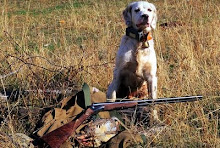Dogs – especially sporting dogs - are particularly susceptible to heat stroke. This is a primary danger to our bird dogs. Your dog is far more likely to suffer heatstroke than snakebite, coyote attack, or any other medical problem in the field. It happens rapidly and is often fatal. Because dogs have limited ability to control body temperature (mainly respiration), these mechanisms can fail to control temperatures, and the stage is set for heat stroke.
Once a dog's body temperature passes above about 105⁰F, changes begin to occur that make it difficult to regain normal temperatures. Oxygen demand increases beyond what can be supplied. As temperature elevates past 108⁰F , cellular damage starts to occur in the kidneys, liver, blood, gastrointestinal tract, heart and brain – how much damage depends on the temperature and duration. Even dogs that do not die immediately may (or will) experience continued problems and die several days later. I know people who have lost dogs they thought would survive, and it is a heartbreaker.
Aggravating factors
Obviously, heat, but it does not have to be extremely hot. Exertion, humidity, lack of hydration, use of some drugs (like antihistamines), and lack of air circulation (as in a closed vehicle or crate) are all associated with canine heat stroke.
Extreme activity will drive body temperatures up very quickly. After high activity, return the dog to an air conditioned space, or wet your dog down stake him out in an area that is shaded and breezy to allow evaporation to further cool the dog. Do not return a wet dog to an enclosed crate – evaporative cooling requires air circulation. Provide plenty of cool fresh water both before and after activity. When hunting and trialing, I find that a dog is usually very receptive to a drink once he has run for 5 or 10 minutes. This is an opportunity to get extra fluids into the dog before he actually needs it. Keep the dogs weight down, provide exercise regularly, and be careful with older dogs.
Evaporative cooling becomes less efficient as the relative humidity rises, so humidity is an important factor as well. Jim Michaletz, a Missouri field trailer, has suggested that combining the air temperature (⁰F) and relative humidity figure is a good index. If, for instance, it is 70⁰F with a relative humidity of 70% to total number would be 140. It could be 85⁰F with a relative humidity of 40% and the total is 125 -- effectively lower. Jim says that he stops running dogs when the combined number gets above 140.
Evaporative cooling becomes less efficient as the relative humidity rises, so humidity is an important factor as well. Jim Michaletz, a Missouri field trailer, has suggested that combining the air temperature (⁰F) and relative humidity figure is a good index. If, for instance, it is 70⁰F with a relative humidity of 70% to total number would be 140. It could be 85⁰F with a relative humidity of 40% and the total is 125 -- effectively lower. Jim says that he stops running dogs when the combined number gets above 140.
Signs of heat stroke
Dogs suffering heat stroke will exhibit disorientation, staggering or stumbling, excessive and uncontrolled panting and accelerated heart rate. The gums may appear grayish-pink. They often do not want water or food. When in doubt, assume that the dog has heat stroke and take immediate steps to cool the pup down.
First aid and follow-up
In my opinion, it is far better to over-react than to simply wait and see. Get the dog cool as soon as humanly possible – immersion in cool water will rapidly lower body temperature. Get the dog to a vet immediately for blood tests and IV hydration. If there has been damage the blood test will indicate and additional therapy may be required.
Remember, it's a lot hotter at ground level that on the back of a horse, on an ATV, or even walking. Be careful out there. Better, I think, to err on the side of caution and pick that pup up before he tires and overheats.
EDIT -- I see that there is another useful piece on canine heat stroke on Strideaway by Shawn Wayment, DVM. I highly recommend it! - MS
EDIT -- I see that there is another useful piece on canine heat stroke on Strideaway by Shawn Wayment, DVM. I highly recommend it! - MS









2 comments:
Good post and I hope a lot of people read it. Every year you read about, hear about or witness someone losing a dog to heat. Early in the morning and late in the evening for short periods is the rule during hot weather.
I was over at Maurice's last Saturday and he just received some 8-9 week old quail. He's not working them at all for fear of stressing them too much in this oppressive heat we're having. It's not just the dogs that can suffer.
I am done with summer and we're not even in August yet. I can't remember ever looking forward to fall and cooler weather more than I am this year.
Mike: I remind folks in the northeast about the magic number '140' a lot. We get plenty of 'cool' but very muggy fall days where it might never top 70degs, but the high probability of rain or thunder drives the humidity up and together they really put stress on the dogs.
Got back from the cool of Arizona yesterday, left my own little rocketship out there for the remaining six weeks, and am excited to see how much polish Bill can get on him in that time.
Andrew
Post a Comment